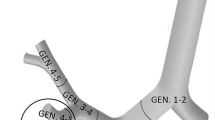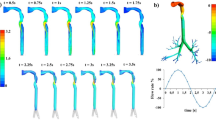Abstract
Bronchial clearance of deposited particles was simulated using a stochastic model of the tracheobronchial tree. The clearance model introduced in this study considers (1) a continuous decrease of the mucus thickness from the trachea to the terminal bronchioles according to a linear or an exponential function, (2) the possibility of mucus discontinuities, which are mainly found in intermediate and distal airways of the tracheobronchial compartment, (3) mucus production in proximal airways, (4) a slow bronchial clearance phase due to the capture of a defined particle fraction f s in the periciliary sol phase, and (5) an eventual delay of the mucociliary transport at carinal ridges of airway bifurcations. Based on the concept of mucus volume conservation in single bifurcations, a reduction of the thickness of the mucus blanket from proximal to distal airways causes a significant increase of the mucus velocities in small ciliated airways compared to other stochastic modeling predictions assuming a constant thickness of the mucus layer throughout the conducting airways. This effect is further enhanced by the consideration of mucus discontinuities. In contrast, the ability of bronchial airways to produce a certain volume of mucus has a decreasing effect on the mucus velocities. In all generated clearance velocity models, mucociliary clearance is completely terminated within 24 h after exposure, consistent with the experimental evidence. Implementation of a slow bronchial clearance phase predicts a long-term retention fraction, which is fully cleared from the lung after several weeks. For 1-μm MMAD particles, 24-h retention varies between 0.42 and 0.52, in line with the suggestions of the ICRP. Mucus delay at carinal ridges only affects short-term clearance by increasing the retained particle fraction at a given time, while long-term retention is not influenced.
Similar content being viewed by others
References
Albert, R.E., Arnett, L.C., 1955. Clearance of radioactive dust from the human lung. AMA Arch. Ind. Health 12, 99–106.
Albert, R.E., Lippmann, M., Briscoe, W., 1969. The characteristics of bronchial clearance in humans and the effects of cigarette smoking. Arch. Env. Health 18, 738–755.
Anjilvel, S., Asgharian, B., 1995. A multiple-path model of particle deposition in the rat lung. Fund. Appl. Toxicol. 28, 41–50.
Asgharian, B., Hofmann, W., Miller, F.J., 2001. Mucociliary clearance of insoluble particles from the tracheobronchial airways of the human lung. J. Aerosol Sci. 32, 817–832.
Brain, J.D., Gehr, P., Karvet, R.I., 1984. Airway macrophages: The importance of the fixation method. Ann. Rev. Resp. Dis. 129, 823–826.
Cuddihy, R.G., Yeh, H.C., 1988. Respiratory tract clearance of particles and substances dissociated from particles. In: Mohr, U. (Ed.), Inhalation Toxicology: The Design and Interpretation of Inhalation Studies and Their Use in Risk Assessment. Springer, Berlin, pp. 169–193.
Gehr, P., Im Hof, V., Geiser, M., Schürch, S., 1991. The fate of particles deposited in the intrapulmonary conducting airways. J. Aerosol Med. 4, 349–361.
Geiser, M., Cruz-Orive, L., Im Hof, V., Gehr, P., 1990. Assessment of particle retention and clearance in the intrapulmonary conducting airways of hamster lungs with the fractionator. J. Microsc. 160, 75–88.
Hofmann, W., Martonen, T., Menaché, M., 1990. A dosimetric model for localised radon progeny accumulations at tracheobronchial bifurcations. Rad. Prot. Dosim. 30, 245–259.
Hofmann, W., Koblinger, L., 1992. Monte Carlo modeling of aerosol deposition in human lungs. Part III: Comparison with experimental data. J. Aerosol Sci. 23, 51–63.
Hofmann, W., Asgharian, B., Winkler-Heil, R., 2001a. Modeling intersubject variability of particle deposition in human lungs. J. Aerosol Sci. 33, 219–35.
Hofmann, W., Sturm, R., Asgharian, B., 2001b. Stochastic simulation of particle clearance in human bronchial airways. J. Aerosol Sci. 32(Suppl.), S807–S808.
Hofmann, W., Asgharian, B., 2003. The effect of lung structure on mucociliary clearance and particle retention in human and rat lungs. Toxicol. Sci. 73, 448–456.
Hofmann, W., Sturm, R., 2004. Stochastic model of particle clearance in human bronchial airways. J. Aerosol Med. 17, 73–89.
International Commission on Radiological Protection (ICRP), 1994. Human respiratory tract model for radiological protection. Publication 66. Ann. ICRP, Pergamon Press, Oxford, UK.
Iravani, J.D., Van As, A., 1972. Mucus transport in the tracheobronchial tree of normal and bronchitic rats. J. Pathol. 106, 81–93.
Koblinger, L., Hofmann, W., 1985. Analysis of human lung morphometric data for stochastic aerosol deposition calculations. Phys. Med. Biol. 30, 541–556.
Koblinger, L., Hofmann, W., 1990. Monte Carlo modeling of aerosol deposition in human lungs. Part I: Simulation of particle transport in a stochastic lung structure. J. Aerosol Sci. 21, 661–674.
Lee, P.S., Gerrity, T.R., Hass, F.J., Lourenco, R.V., 1979. A model for tracheobronchial clearance of inhaled particles in man and a comparison with data. IEEE Trans. Biomed. Eng. 26, 624–630
Luchtel, D.L., 1976. Ultrastructural observations on the mucous layer in pulmonary airways. J. Cell Biol. 70, 350a.
Mercer, R.R., Russell M.L., Crapo, J.D., 1992. Mucous lining layers in human and rat airways. Ann. Rev. Resp. Dis. 145, 355.
Mercer, R.R., Russell, M.L., Roggli, V.L., Crapo, J.D., 1994. Cell number and distribution in human and rat airways. Am. J. Resp. Cell Mol. Biol. 10, 613–624.
Mussatto, D.J., Garrard, C.S., Lourenco, R.V., 1988. The effect of inhaled histamine on human tracheal mucus velocity and bronchial mucociliary clearance. Am. Rev. Resp. Dis. 138, 774–779.
National Council on Radiation Protection and Measurements (NCRP), 1997. Deposition, retention, and dosimetry of inhaled radioactive substances, Report No. 125, Oxford.
Oberdörster, G., 1988. Lung clearance of inhaled insoluble and soluble particles. J. Aerosol Med. 1, 289–330.
Raabe, O.G., Yeh, H.C., Schum, G.M., Phalen, R.F., 1976. Tracheobronchial geometry: Human, dog, rat, hamster — A compilation of selected data from the project respiratory tract deposition models. Report LF-53. Lovelace Foundation, Albuquerque, New Mexico.
Scheuch, G., Stahlhofen, W., Heyder, J., 1996. An approach to deposition and clearance measurements in human airways. J. Aerosol Med. 9, 35–41.
Stahlhofen, W., Gebhart, J., Rudolf, G., Scheuch, G., 1986. Measurement of lung clearance with pulses of radioactivity-labelled aerosols. J. Aerosol Sci. 17, 330–336.
Stahlhofen, W., Koebrich, R., Rudolf, G., Scheuch, G., 1990. Short-term and long-term clearance of particles from the upper human respiratory tract as a function of particle size. J. Aerosol Sci. 21(Suppl.), S407–S410.
Sturgess, J.M., 1977. The mucous lining of major bronchi in the rabbit lung. Am. Rev. Resp. Dis. 115, 819–827.
Sturm, R., Hofmann, W., 2003. Mechanistic interpretation of the slow bronchial clearance phase. Rad. Prot. Dosim. 105, 101–104.
Sturm, R., Hofmann, W., Scheuch, G., Sommerer, K., Svartengren, M., Camner, P., 2002. Particle clearance in human bronchial airways: Comparison of stochastic model predictions with experimental data. Ann. Occ. Hyg. 46(Suppl.), 329–333.
Weibel, E.R., 1963. Morphometry of the Human Lung. Academic Press, New York.
Wolff, R.K., 1989. Mucociliary function. In: Parent, R.A. (Ed.), Comparative Biology of the Normal Lung. CRC Press, New York, pp. 659–680.
Yeates, D.B., Gerrity, T.R., Garrard, C.S., 1982. Characteristics of tracheobronchial deposition and clearance in man. Ann. Occ. Hyg. 26, 245–257.
Yeh, H., Schum, G.M., 1980. Models of Human lung airways and their application to inhaled particle deposition. Bull. Math. Biol. 42, 461–80.
Yu, C.P., Hu, J.P., Yen, B.M., Spektor, D.M., Lippmann, M., 1986. Models for mucociliary particle clearance in lung airways. In: Lee, S.D., Schneider, T., Grant, L.D., Verkerk, P.J. (Eds.), Aerosols: Research, Risk Assessment and Control Strategies, MI, Lewis, Chelsea, pp. 569–578.
Author information
Authors and Affiliations
Corresponding author
Rights and permissions
About this article
Cite this article
Sturm, R., Hofmann, W. Stochastic Modeling Predictions for the Clearance of Insoluble Particles from the Tracheobronchial Tree of the Human Lung. Bull. Math. Biol. 69, 395–415 (2007). https://doi.org/10.1007/s11538-006-9143-3
Received:
Accepted:
Published:
Issue Date:
DOI: https://doi.org/10.1007/s11538-006-9143-3




